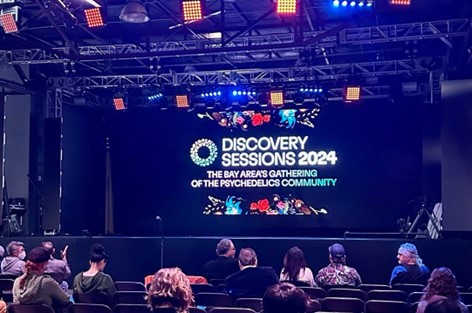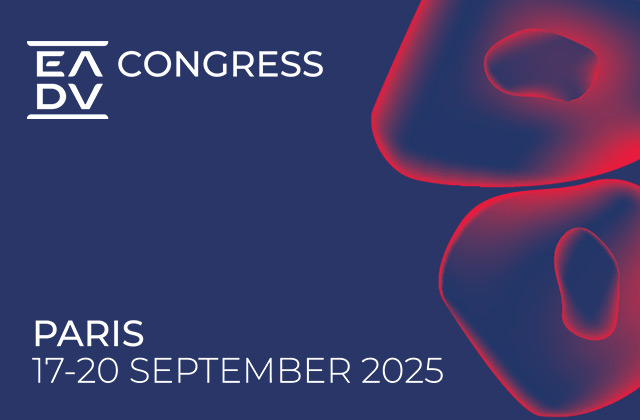
What do you think of when you think of psychedelics? Groovy, oscillating patterns and hippies on drugs? What about a ketamine-assisted therapy clinic, or patients who are overcoming their post-traumatic stress disorder (PTSD) and treatment-resistant depression? Increasingly, the clinical benefits of psychedelic medicines are moving to the forefront as further research is conducted and societal acceptance slowly grows. The once-taboo topic of psychedelic medicines is not just hype: they may offer life-changing options for those suffering from chronic mental health issues.
On April 18-19, 2024, Discovery Sessions held its third annual gathering of the psychedelics community in San Francisco. The conference seeks to bring together inspirational thought-leaders at the forefront of psychedelics across culture, policy, science, and business to engage in spirited, inclusive dialogue.
Background Reading: See our 2021 whitepaper for a primer on the substances and key players and our 2022 update, Psychedelics as a Catalyst for a New Mental Healthcare Model.
What’s the latest in this industry, and what lies ahead? Here we explore those questions and share some key takeaways from Discovery Sessions 2024
1. Creative clinical trial designs for psychedelics can help address blinding issues
As we’ve previously discussed, there are numerous ongoing trials of psychedelics for conditions including alcohol use disorder, opioid use disorder, tobacco cessation, depression, PTSD, obsessive-compulsive disorder (OCD), anxiety, and even end of life palliative support. Significant benefits have been observed across many of these, with reasonable safety profiles, as well.
However, there are many challenges when it comes to designing trials for psychedelic medicines, one of which is the blinding or masking of the experimental arm. The Stanford Heifets Lab identified one potential solution to this, which Dr. Boris Heifets, MD, PhD, discussed at the conference. In the Heifets Lab study, patients with moderate-to-severe depression presenting for routine surgery were randomized to either ketamine infusion or placebo (normal saline infusion) alongside their surgical anesthesia.
The unique combination of ketamine or placebo with surgical anesthesia prevented patients from easily guessing which treatment arm they had been assigned. Though there was no significant difference observed between the two treatment groups, both groups experienced a strong antidepressant response of a ~47% decrease in score on the MADRS scale that was used to measure depression severity, with the placebo group also considerably outperforming standard post-surgical outcomes.
Though this type of masking strategy is unlikely to be feasible for most trials, companies designing future trials should similarly seek creative solutions to mask treatment assignments and minimize expectancy bias.
2. The Schedule 1 legal status of psychedelics may be changing soon, given the upcoming FDA decision on MDMA-AT for PTSD
As psychedelics are all controlled substances, the cost to produce and acquire them for clinical use is very high. They must be manufactured, stored, and distributed under highly controlled conditions, such as the FDA’s Risk Evaluation and Mitigation Strategy (REMS) program. This increases costs and puts the drugs at prices many times higher than those available through underground markets.
However, there are potential changes on the horizon for psychedelic drug scheduling. An FDA decision is expected on August 14 for Lykos Therapeutics’ submission of MDMA-assisted therapy (MDMA-AT) for PTSD. If approved, this would require MDMA to be rescheduled, as it will no longer fall into the Schedule 1 controlled substance category of drugs with “no accepted medical use.” This would be a positive sign for other psychedelic-based medicines currently in development and could pave the way for legislative reform to support greater access for patients in the future.
The Drug Enforcement Administration is also expected to reclassify marijuana this year, following legislation put forth by the Biden administration. It is expected to move from the strictest Schedule I to the less stringent Schedule III, based on a review from federal scientists concluding that there is credible evidence that cannabis provides medical benefits and that it poses lower health risks than other controlled substances. This can be seen as part of a broader trend of re-evaluating botanicals and other compounds as more multifaceted substances with therapeutic applications.
3. New models of therapy delivery and potentially even new types of psychedelic medicines are needed to lower costs and expand access
The looming cost of psychedelic healthcare was a key topic at Discovery Sessions. While psychedelic medicines can be cost-effective overall, many challenges remain in developing accessible and cost-effective delivery models.
The dominant therapeutic model involves multiple preparation and treatment sessions, as well as post-treatment evaluation. While this approach is proven and helps to support patient safety, it comes at a significant cost, as two facilitators are required throughout the entire process for each patient. Acquiring psychedelics through legal channels isn’t cheap either, with drug purchasing accounting for up to 60% of total therapy costs.
All this means that in regions like Oregon, where supervised psychedelic use is legal, sessions range from $3,000 to $5,000, with full treatment series reaching $10,000 to $15,000. Despite these prices, current regulatory constraints, the lack of tax benefits, and low patient volumes have limited the development of sustainable business models, and exacerbated concerns regarding scalability. Notably, the current setup not only restricts the number of patients served but also perpetuates inequities, as only those with disposable income can afford access.
The role of payers will be critical to help address some of these challenges. Convincing public and private insurers to cover these treatments will be essential to prevent their relegation to underground markets. Despite the hurdles, evidence suggests that psychedelic therapies can be cost-effective over the long-term. One speaker at Discovery Sessions suggested a “breakeven point” of approximately three years, through reduced usage of other mental health and general health services.
We will be looking towards potential future innovations, such as the next-generation of psychedelic medicines that could potentially be taken safely at home, to improve accessibility for marginalized communities lacking resources for facilitated in-person sessions.
4. There is a unique need to understand the histories of these plant medicines and integrate the traditional wisdom and cultures associated with them.
A final key theme at Discovery Sessions was the importance of respecting the historical and cultural contexts of these substances. Psychedelics like the DMT-containing ayahuasca plant and psilocybin, found in “magic mushrooms,” have been used for centuries by indigenous communities in various spiritual and healing practices.
Given this, companies patenting psychedelic-based products without acknowledging or giving back to the communities in which they originated can provoke controversy. We saw this with the patenting of DMT vape pens in 2022. This and other incidents have created a sense of tension between some communities and sparked concerns about the medicalization and corporatization of these ancient, natural substances. Though not explored in detail here, some potential initiatives have been proposed to support greater reciprocity, such as sharing profits with indigenous owned trusts or conservation funds.
Cultural learnings derived from outside of the classical clinical setting should also be integrated, where possible. Encouragingly, we see acknowledgment of the importance of set (psychological expectations) and setting (physical environment), and the clinician-patient relationship, growing in this wave of psychedelic development.
As psychedelic plant medicines increase in popularity, stakeholders are encouraged to continue to consider how to honor and integrate the traditional wisdom and cultural narratives intertwined with their use.
Conclusion
As the landscape of psychedelic-assisted therapies continues to evolve and interest grows, some say we are currently in the midst of a psychedelic renaissance. However, a tremendous amount of work remains to be done to gain widespread acceptance, access, and uptake.
Through open dialogue and thoughtful action, we have the opportunity to confront the challenges ahead and collectively embrace the potential therapeutic benefits of these plant medicines.






